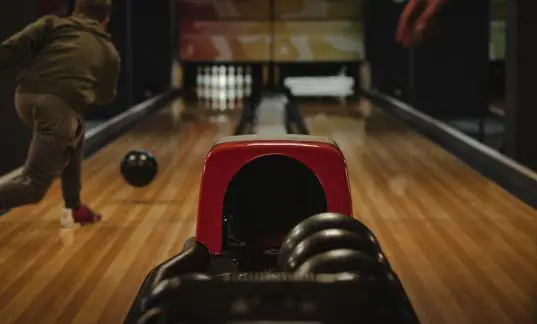While there are plenty of commercial bowling ball cleaners on the market which are worth the investment for most bowlers (as we detailed in our previous guide on homemade and commercial cleaners), budget-conscious and DIY bowlers alike are always searching for homemade options. There are a ton of different thoughts on what to use and what not to use to clean a bowling ball at home – so much so that it can be confusing and hard to find a consensus which makes legitimate sense.
We’re here to clear that all up. There are several effective ways for you to clean a bowling ball at home, using cleaning products you already have in your pantry instead of shelling out a pretty penny to buy a commercial bowling ball cleaner off of Amazon. This guide is here to provide the best consensus DIY bowling ball cleaning options out there, while also clearing up conjecture on the do’s and don’t’s of homemade bowling ball cleaning.
Let’s start with a simple how-to for the best way to clean your bowling ball at home.
4 Steps For How To Clean A Bowling Ball At Home
- If you need a quick clean, wiping down your ball with rubbing alcohol sparsely applied to a no-lint. microfiber towel is a good way to go. However, this next method is the real bowling ball cleaning deal, basically acting to pull oil up and out from deep within your ball’s pores. The trade-off, though, is that too much deep cleaning can lead to cracks and fissures in your bowling ball’s cover stock.
If you’re regularly playing on oily lanes, a deep clean is recommended every 50 games or so. Regulated lanes require less, with an average of 75-100 games recommended. Just keep an eye on your ball. If your bowling ball’s action is starting to dull, it’s probably time for a deep clean. - Use waterproof tape to tape over the finger holes of your bowling ball. Ensure there are no cracks through which water can seep in. Make the tap as flat to the surface of the ball as you can, using an extra piece of tape if necessary to ensure coverage.
- Fill a bucket with hot water, enough to submerge the entire ball. Oil is lighter than water, so this method works to lift the oil out of the pores of your ball along with any dirt and grime which was packed in with it. For maximum effect, soak the ball for about 20 minutes.
- Lift the ball from the bucket. Dry off the bowling ball with a lint-free towel with the tape still in place, careful to get off any excess water that may have pooled near the seams of the tape. Once the ball is mostly dry, take off the tape and dry it again with a careful ey.
Can You Use Windex To Clean A Bowling Ball?
Windex is a United States Bowling Congress-approved bowling ball cleaning agent, but it may not be the best overall homemade bowling ball cleaning option out there – at least not as a one-stop option. According to most bowlers who have used Windex as a bowling ball cleaner, it does wonders getting dirt and grime off the bowling ball.
However, Windex is not designed to extract oils from the pores of the bowling ball. So, you’ll likely still need to use something like rubbing alcohol in conjunction with Windex in order to clean your bowling ball’s cover stock thoroughly. A more effective overall option would be a 1:1:1 ratio of Simple Green (to degrease), ammonia (for basic cleaning), and rubbing alcohol (for oil extraction).
Windex can be a great option if your ball has been mucked up by more than just oil at the lanes, but there are better homemade bowling ball cleaning options out there for you.
How Do I Clean The Finger Holes In My Bowling Ball?
You never want to soak your bowling ball with the finger holes open, nor douse the insides of your finger holes with any cleaning substance. You can do major damage to not only the feel of your finger holes, but the core and weight block area of the bowling ball. Your best bet is to get a dry, lint-free microfiber towel and be thorough in wiping the insides of each finger hole.
Use your finger to insert the towel with solid force into the ball, careful to wipe all sides of each hole and the rim of the finger hole as well. Be sure that the towel you’re using is free of oils from previous ball cleaning, or any cleaning substances you’ve been using to clean the cover stock.
How Often Should I Polish My Bowling Ball?
The condition of your bowling ball and its cover stock will play a key determining factor in how often you should re-polish and scuff the ball. If the ball has been well-used and isn’t in the best overall condition, it behooves you to polish the ball and scuff it every ten games or so. Because it’s already suffering from cover stock issues which is likely adding a level of inconsistency to its lane action, regular polishing is a must to get the most out of a tool that’s worn out.
Newer bowling balls with a shiny cover stock don’t require nearly as many polishing and scuff jobs, with the general rule being every 30 games or so. A full resurface job is recommended every 60-100 games, depending on the oil and overall conditions of the lanes you regularly play on.
Can You Use Acetone To Clean A Bowling Ball?
Acetone is an extremely dangerous proposition when it comes to homemade cleaning options for bowling balls, as it has been known to weaken polyester cover stocks and strip off any ball’s polish when used too liberally. Acetone is extremely potent and, while some pro shops swear by it in moderation, there are much safer alternatives out there which work to extract oil from the pores of your ball while also removing dirt and grime.
There are many horror stories in online forums of how acetone killed a ball’s overall reaction and weakened its composition, making it something you likely want to avoid unless there’s something caked on the ball like super glue. If you’re going for a homemade bowling ball cleaner, rubbing alcohol is a much safer and more gentle option for your cover stock’s health.
Closing Thoughts
Whether you’re avoiding commercial bowling ball cleaners in hopes of saving money, or you’re just really into DIY options for keeping your ball in pristine shape, there are bowling ball cleaning options available for you which may in fact already be in your house.
Remember to exercise these options with care, as improper cleaning and adherence to the above steps could do more harm to your bowling ball than good. However, when done right, homemade bowling ball cleaners do the trick and will help maximize your bowling ball for the best scores and shot action possible.

